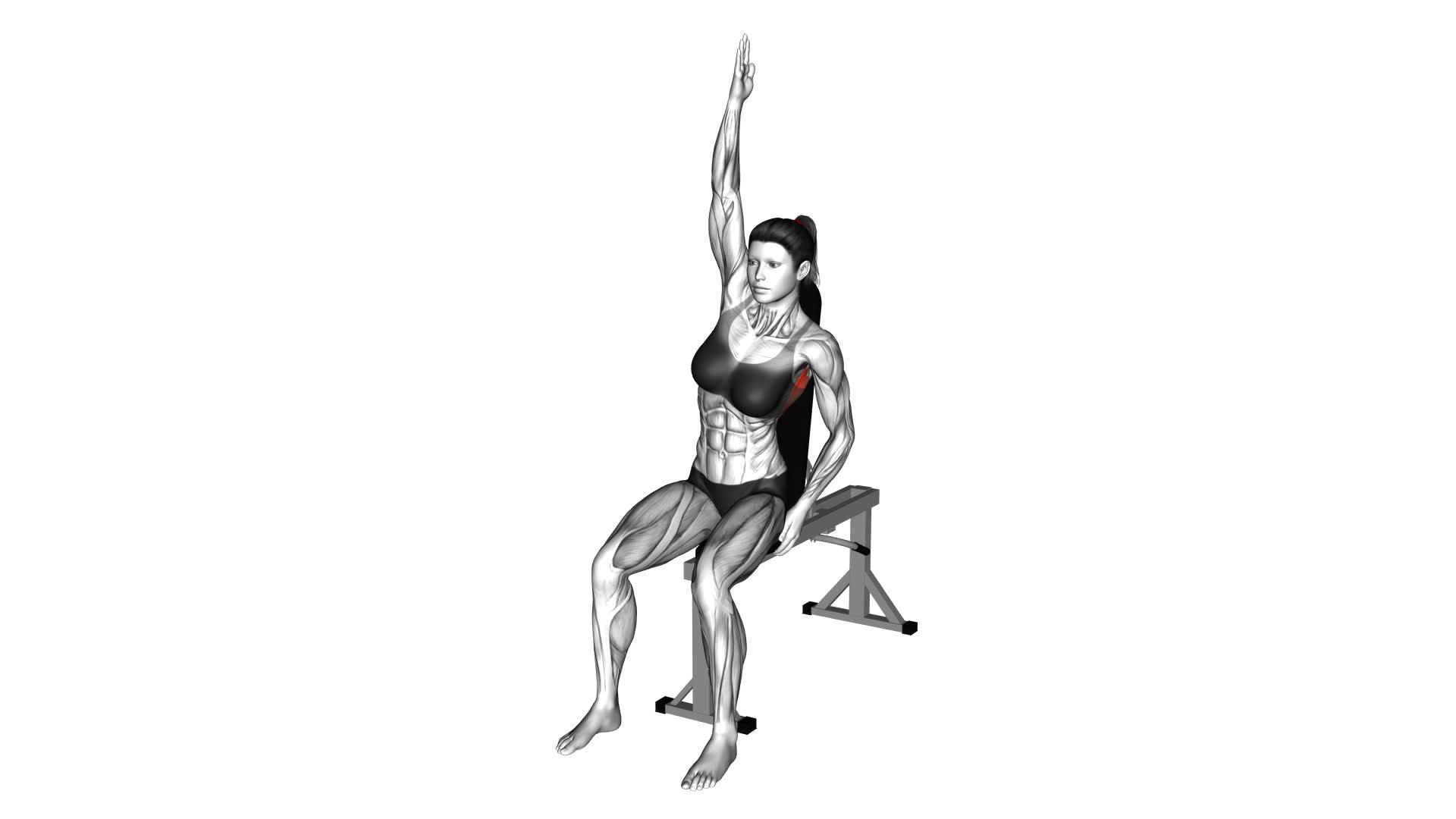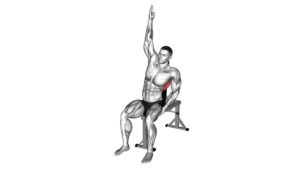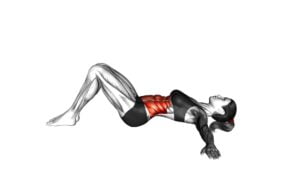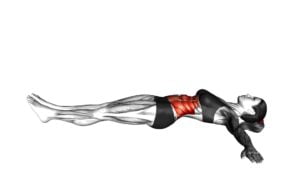Seated Lower Back Stretch (female) – Video Exercise Guide & Tips

Are you looking for an effective way to stretch your lower back? Look no further!
Watch This Exercise Video
In this video exercise guide, we'll show you how to perform the seated lower back stretch. This stretch not only helps relieve tension and improve flexibility, but it also targets key muscles in your lower back.
So grab a chair and get ready to alleviate discomfort and improve your overall fitness.
Let's get started!
Key Takeaways
- Seated Lower Back Stretch relieves tension and improves flexibility.
- It targets key muscles in the lower back and increases range of motion.
- It helps prevent and alleviate lower back pain and improves posture.
- Proper form and technique, as well as modifications based on fitness level, are crucial for maximizing effectiveness and preventing injuries.
Benefits of the Seated Lower Back Stretch
To experience the benefits of the Seated Lower Back Stretch, sit on the edge of a chair and lean forward, reaching towards your toes. This simple exercise can greatly improve flexibility and provide relief from lower back pain. By stretching the muscles in your lower back, you can increase your range of motion and prevent stiffness. This can be especially beneficial for those who spend long hours sitting or have a sedentary lifestyle.
Stretching the lower back also helps to alleviate tension and tightness in the muscles. As you lean forward, you'll feel a gentle stretch in your lower back, which can help to release any built-up stress or discomfort. Regularly performing this stretch can help to prevent and reduce lower back pain caused by muscle imbalances or tightness.
In addition to improving flexibility and relieving lower back pain, the Seated Lower Back Stretch can also help to improve posture. By stretching the muscles in your lower back, you can alleviate any strain or tension that may be affecting your posture. This can lead to better alignment and reduced risk of developing postural issues or back pain in the future.
Proper Form and Technique for the Exercise
Achieving proper form and technique for the Seated Lower Back Stretch is crucial for maximizing its effectiveness and minimizing the risk of injury. Flexibility in the lower back is essential for maintaining a healthy spine and preventing discomfort or pain. When performing the seated lower back stretch, there are a few key points to keep in mind to avoid injury.
Firstly, it's important to sit up straight with your back against a wall or chair for support. This helps to maintain proper alignment and prevents excessive strain on the lower back.
Secondly, be mindful of your breathing throughout the stretch. Inhale deeply, and as you exhale, gently lean forward from your hips, keeping your back straight. Avoid rounding your back or hunching your shoulders.
As you lean forward, you should feel a gentle stretch in your lower back. It's important to listen to your body and not push beyond your comfort level. Hold the stretch for 20-30 seconds, and then slowly return to the starting position.
Modifications and Variations for Different Fitness Levels
When modifying the seated lower back stretch for different fitness levels, adjust the intensity and range of motion to suit your abilities. Modifications can be made to make the stretch easier or more challenging, depending on your fitness level.
If you're a beginner or have limited flexibility, you can start by sitting on a cushion or folded blanket to elevate your hips slightly. This will decrease the intensity of the stretch and make it more accessible. As you progress and become more comfortable, you can gradually remove the cushion or blanket to increase the stretch.
Another modification is to decrease the range of motion by bending your knees slightly and bringing them closer to your chest. This will lessen the stretch on your lower back while still providing some relief.
On the other hand, if you're more advanced and looking for a deeper stretch, you can try extending your legs straight out in front of you. This will increase the intensity and target your lower back more effectively.
Remember to listen to your body and only go as far as feels comfortable for you. Progressions can be made gradually over time as your flexibility and strength improve.
Common Mistakes to Avoid During the Seated Stretch
During the seated lower back stretch, it's important to be aware of common mistakes that can hinder the effectiveness of the exercise. To ensure you're getting the most out of this stretch and avoiding any potential injuries, here are four common mistakes to avoid and tips to maintain proper form:
- Slouching: One of the most common mistakes is slouching during the stretch. This can put unnecessary strain on your lower back and negate the benefits of the exercise. Instead, sit up tall and engage your core muscles to maintain proper alignment.
- Overstretching: While it's important to feel a gentle stretch in your lower back, avoid pushing yourself too far. Overstretching can lead to muscle strains or even herniated discs. Focus on gradually increasing the stretch without going beyond your comfort zone.
- Holding your breath: Many people tend to hold their breath while stretching, which can increase tension in the body. Remember to breathe deeply and consciously throughout the exercise to promote relaxation and proper oxygen flow to your muscles.
- Neglecting other muscles: The seated lower back stretch primarily targets the lower back, but it's important not to neglect other muscles that contribute to a healthy back. Incorporate exercises that strengthen your core, hips, and glutes to provide support and stability to your lower back.
Tips for Incorporating the Seated Lower Back Stretch Into Your Fitness Routine
To effectively incorporate the seated lower back stretch into your fitness routine, prioritize consistency and gradual progression. Stretching is an essential component of any fitness routine, as it helps improve flexibility and prevent injuries. By regularly incorporating the seated lower back stretch, you can experience numerous benefits.
Flexibility is crucial for maintaining proper posture and range of motion, both in everyday activities and during exercise. Stretching the lower back can help alleviate tension and tightness, reducing the risk of strain or discomfort. Additionally, stretching increases blood flow to the muscles, improving overall circulation and aiding in muscle recovery.
When incorporating the seated lower back stretch into your fitness routine, start with a gentle warm-up to prepare your body. Gradually increase the intensity and duration of the stretch over time, allowing your muscles to adapt and become more flexible. It's important to listen to your body and avoid pushing yourself too far, as this can lead to injury.
To ensure the effectiveness of the seated lower back stretch, maintain proper form throughout the exercise. Sit tall with your back straight, and slowly lean forward from the hips, keeping your chest lifted and your shoulders relaxed. Hold the stretch for 20-30 seconds, breathing deeply and focusing on releasing tension in your lower back.
Frequently Asked Questions
Can the Seated Lower Back Stretch Help Alleviate Lower Back Pain Caused by Pregnancy?
Yes, the seated lower back stretch can help alleviate lower back pain caused by pregnancy. This stretch targets the muscles in your lower back, which can become strained during pregnancy. By stretching these muscles, you can relieve tension and discomfort.
However, it's important to consult with your healthcare provider before attempting any new exercises, especially if you have a herniated disc. They can provide guidance on whether this stretch is appropriate for your specific condition.
Is It Safe to Perform the Seated Lower Back Stretch if I Have a Herniated Disc?
If you have a herniated disc, it may not be safe to perform the seated lower back stretch. This exercise could potentially aggravate your condition.
It's important to consult with a healthcare professional to determine the best course of action. They may suggest alternative stretches or exercises that can help alleviate your lower back pain without putting strain on your herniated disc.
Your safety and well-being should always be the top priority.
How Often Should I Do the Seated Lower Back Stretch to See Noticeable Improvements in Flexibility?
To improve flexibility, it's important to do the seated lower back stretch regularly. The recommended frequency for noticeable improvements is to perform this stretch at least three to four times a week.
Consistency is key. By incorporating the seated lower back stretch into your routine consistently, you can gradually enhance your flexibility over time.
Remember to listen to your body and adjust the frequency based on your individual needs and limitations.
Can the Seated Lower Back Stretch Be Beneficial for Athletes Looking to Improve Their Performance?
To improve your athletic performance, incorporating the seated lower back stretch into your routine can be highly beneficial.
This stretch helps increase flexibility in your lower back, which can enhance your range of motion and prevent injury.
By regularly performing this stretch, you can improve your overall agility, power, and stability, leading to better performance in sports and physical activities.
The seated lower back stretch offers numerous benefits for athletes aiming to reach their peak potential.
Are There Any Additional Stretches or Exercises That Can Be Paired With the Seated Lower Back Stretch for Maximum Benefits?
To maximize the benefits of the seated lower back stretch, try incorporating additional stretches and exercises. By targeting different muscle groups, you can enhance your overall flexibility and strength.
Consider including stretches like the cat-camel stretch or the child's pose to further stretch your back and relieve tension.
Also, try partnering up for some partner-assisted stretches, which can provide a deeper stretch and help improve your range of motion.
Don't forget to listen to your body and stop if you feel any pain or discomfort.
Conclusion
Incorporating the seated lower back stretch into your fitness routine can provide numerous benefits, including improved flexibility and reduced lower back pain.
By following proper form and technique, and making modifications as needed for your fitness level, you can safely and effectively stretch your lower back muscles.
Avoiding common mistakes and incorporating this stretch regularly can help you maintain a healthy and strong lower back.

Author
Years ago, the spark of my life’s passion ignited in my mind the moment I stepped into the local gym for the first time. The inaugural bead of perspiration, the initial endeavor, the very first surge of endorphins, and a sense of pride that washed over me post-workout marked the beginning of my deep-seated interest in strength sports, fitness, and sports nutrition. This very curiosity blossomed rapidly into a profound fascination, propelling me to earn a Master’s degree in Physical Education from the Academy of Physical Education in Krakow, followed by a Sports Manager diploma from the Jagiellonian University. My journey of growth led me to gain more specialized qualifications, such as being a certified personal trainer with a focus on sports dietetics, a lifeguard, and an instructor for wellness and corrective gymnastics. Theoretical knowledge paired seamlessly with practical experience, reinforcing my belief that the transformation of individuals under my guidance was also a reflection of my personal growth. This belief holds true even today. Each day, I strive to push the boundaries and explore new realms. These realms gently elevate me to greater heights. The unique combination of passion for my field and the continuous quest for growth fuels my drive to break new ground.







